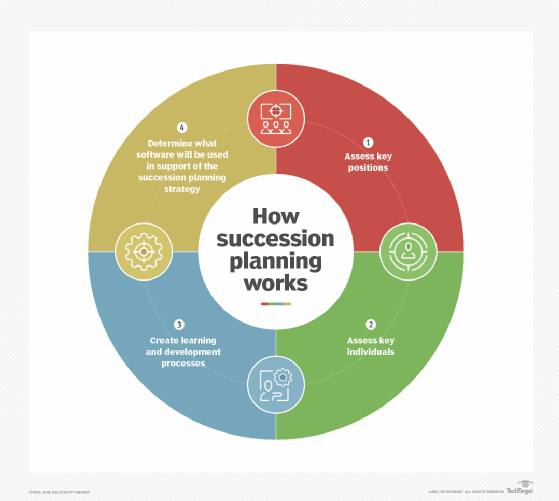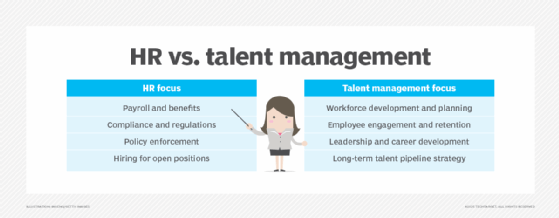What is talent management? Definition, basics and strategy
Talent management is a strategic approach organizations use to attract, develop, retain and optimize employees. Leveraging human resources (HR) processes, workforce planning and employee engagement strategies, talent management is a way organizations can ensure they put the right people in the right roles to drive success.
A well-executed talent management strategy considers hiring needs, skills development, career growth opportunities, succession planning and employee well-being. Organizations that invest in talent management can build a more resilient workforce, improve retention and achieve long-term business growth.
Why is talent management important?
A strong talent management strategy directly influences an organization's ability to meet business objectives and maintain a competitive edge. Without effective talent management, companies might struggle with high turnover, skill shortages, low productivity and disengaged employees.
By implementing proactive workforce planning, organizations can anticipate future talent needs, align their workforce with long-term business goals, and enhance overall employee satisfaction. A well-designed strategy supports career development, promotes a positive workplace culture and fosters continuous innovation.
What are the benefits of using strong talent management?
Organizations that prioritize talent management can experience a range of positive outcomes, including the following:
- Increased employee engagement. Employees who feel valued, supported and challenged are more engaged and productive.
- Higher retention rates. Investing in career growth and professional development encourages employees to stay long-term.
- Better business performance. A well-trained and motivated workforce leads to higher revenue and profitability.
- Stronger employer brand. Companies known for strong talent management practices attract top industry professionals.
- Improved adaptability. Organizations with a flexible talent pipeline can pivot quickly in response to industry changes.
An ideal high-performing employee has industry-specific characteristics. These might include broad or specialized skill sets, knowledge of a product or research area, the ability to learn quickly, and a willingness to gain the skills their employer values.
Members of a company's HR department or leadership team can learn skills to improve their ability to manage the talent within the organization. Talent management software and other HR technologies help hiring teams search for and screen candidates.
There are two common ways to match a desired candidate profile:
- Training current employees to improve their skill set. This involves assessing the employees' current competencies, understanding their ability to learn new skills, investigating their willingness to step into more difficult responsibilities, and retaining them.
- Hiring new employees with skills needed. It can be hard to find an employee who has the skills necessary to perform a job function and is willing to leave their current position somewhere. Finding talent this way is usually more costly than promoting someone, but it could increase the likelihood of them performing their assignments well.
Key components of talent management
Talent management involves multiple processes and strategies that enhance workforce development and ensure organizations maintain a strong talent pipeline.

Workforce planning and talent acquisition
Companies must analyze current workforce capabilities, predict future needs and make sure they hire the right candidates. This involves identifying skill gaps, defining job roles, and leveraging data-driven recruitment strategies.
HR teams use talent acquisition software, AI-driven screening tools, and data analytics to streamline hiring and ensure they select candidates who align with company goals.
Employee training and development
A continuous learning culture is essential for talent retention. Organizations must invest in skills training, leadership development, and career advancement programs.
Offering mentorship, professional certifications, and hands-on learning opportunities can enhance employee capabilities and drive business innovation.
Performance management and feedback
Regular performance evaluations help employees understand their strengths, set career goals and align with company expectations. Transparent goal-setting frameworks, continuous feedback loops, and structured performance reviews are key.
Companies should implement formal review cycles while encouraging ongoing coaching, mentorship, and peer feedback.
Career growth and succession planning
Creating clear career progression paths allows employees to see long-term potential within the company. Providing promotion opportunities, internal mobility options, and leadership development programs helps retain top talent.
Succession planning ensures that critical leadership and specialized roles have qualified internal candidates ready to step in when needed.

Employee experience and engagement
A positive work environment fosters job satisfaction and productivity. Companies should focus on work-life balance, wellness programs, and recognition systems to enhance employee morale.
When employees feel heard, supported, and appreciated, they are more likely to stay loyal to the organization.
How talent management differs from traditional HR
While traditional HR focuses on administrative functions such as payroll, benefits and compliance, talent management is a more holistic and strategic approach to workforce planning.

Modern businesses recognize that HR and talent management must work together to build a future-ready workforce.
6 steps of the talent management process
While each company's approach differs based on its needs, following these six steps can help ensure a comprehensive, successful talent management process.
1. Onboarding
Onboarding is potentially the most crucial aspect of talent management. To train a strong work staff, an organization must start with the right people. Thorough screening for top talent, casting a wide recruiting net, and strong referral incentives are all important.
2. Training
Once employees are invested in their roles and their company, they can be inspired to learn new skills in many ways. For some, the motivation might come simply from wanting to learn more. For others, the existence of incentives -- such as a potential raise or promotion -- could be motivating. Management can create a training matrix to help employees move toward new skills. This process is mutually beneficial as the person's contributions become more valuable and they improve their skill set.
3. Performance analysis and review
A proven way to encourage employees to keep advancing their skill sets and career trajectory is conducting consistent, organized performance reviews. Involving employees in the process of mapping out their goals helps to increase their commitment and investment in learning and development. A common misconception is that training employees makes them more likely to leave a company for better roles elsewhere. However, they are more likely to leave if they are not challenged and allowed to advance within their organization.
4. Advancement and promotion opportunities
Giving employees room to explore different career paths will encourage them to always expand their knowledge and skill sets. Another strategy to encourage advancement is to create an employee development plan. These should include targets for the employee to aim for, goals, tasks, and desired outcomes. They might also include courses or programs the employee could participate in to learn new skills. Mentors and managers should help employees develop their goals and try to align their projected personal outcomes with the company's goals and their careers.
5. Exit interviews
A necessary part of talent management includes offboarding employees. These might be individuals who found new opportunities elsewhere or those who might not have been the best fit with the company's long-term goals or budget. Many legal and emotional considerations go into the exit process, all of which require careful handling. Exit interviews let an employee discuss reasons for leaving and their opinions on the job, managers and organization. An employee's feedback can help the company improve. Previous employees can continue to be assets, helping to place new candidates or find new business for those with whom they maintained positive relationships.
6. Succession planning
Organizational succession planning involves knowing which roles might open when employees move, change roles or retire. It's key for a company to have a plan for these possibilities.
Talent management best practices
Organizations looking to maintain a positive employee experience will attract and retain people from a wider range of geographies and backgrounds. This typically results in greater success than what is feasible with a more limited, homogenous staff.
Other best practices include:
- Creating a strong employer brand. A positive brand reputation attracts top talent.
- Encouraging transparent communication. Open dialogue improves trust and workplace culture.
- Aligning business and employee goals. Employees should see how their roles impact company success.
- Using data-driven decision-making. HR analytics help predict workforce trends and improve hiring.
By prioritizing employee engagement, professional development and strategic hiring, companies can build a more resilient, high-performing workforce.
Retaining talent can be challenging, but strategies such as employee development and flexible work arrangements can prevent employees from looking for other opportunities. Explore top talent retention strategies.







